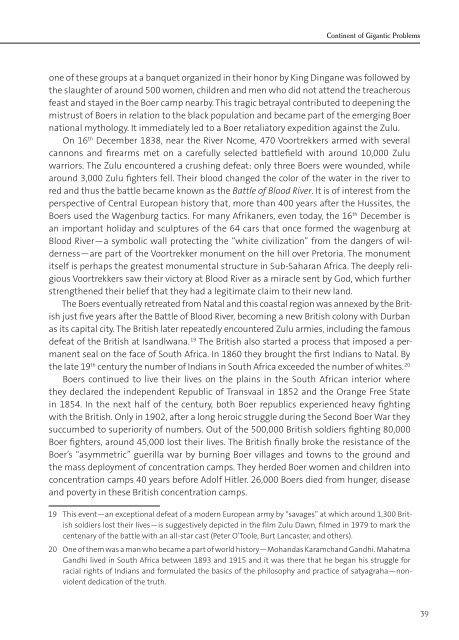Giant_and_Dwarf-FIN
Giant_and_Dwarf-FIN
Giant_and_Dwarf-FIN
You also want an ePaper? Increase the reach of your titles
YUMPU automatically turns print PDFs into web optimized ePapers that Google loves.
Continent of Gigantic Problemsone of these groups at a banquet organized in their honor by King Dingane was followed bythe slaughter of around 500 women, children <strong>and</strong> men who did not attend the treacherousfeast <strong>and</strong> stayed in the Boer camp nearby. This tragic betrayal contributed to deepening themistrust of Boers in relation to the black population <strong>and</strong> became part of the emerging Boernational mythology. It immediately led to a Boer retaliatory expedition against the Zulu.On 16 th December 1838, near the River Ncome, 470 Voortrekkers armed with severalcannons <strong>and</strong> firearms met on a carefully selected battlefield with around 10,000 Zuluwarriors. The Zulu encountered a crushing defeat: only three Boers were wounded, whilearound 3,000 Zulu fighters fell. Their blood changed the color of the water in the river tored <strong>and</strong> thus the battle became known as the Battle of Blood River. It is of interest from theperspective of Central European history that, more than 400 years after the Hussites, theBoers used the Wagenburg tactics. For many Afrikaners, even today, the 16 th December isan important holiday <strong>and</strong> sculptures of the 64 cars that once formed the wagenburg atBlood River—a symbolic wall protecting the “white civilization” from the dangers of wilderness—arepart of the Voortrekker monument on the hill over Pretoria. The monumentitself is perhaps the greatest monumental structure in Sub-Saharan Africa. The deeply religiousVoortrekkers saw their victory at Blood River as a miracle sent by God, which furtherstrengthened their belief that they had a legitimate claim to their new l<strong>and</strong>.The Boers eventually retreated from Natal <strong>and</strong> this coastal region was annexed by the Britishjust five years after the Battle of Blood River, becoming a new British colony with Durbanas its capital city. The British later repeatedly encountered Zulu armies, including the famousdefeat of the British at Is<strong>and</strong>lwana. 19 The British also started a process that imposed a permanentseal on the face of South Africa. In 1860 they brought the first Indians to Natal. Bythe late 19 th century the number of Indians in South Africa exceeded the number of whites. 20Boers continued to live their lives on the plains in the South African interior wherethey declared the independent Republic of Transvaal in 1852 <strong>and</strong> the Orange Free Statein 1854. In the next half of the century, both Boer republics experienced heavy fightingwith the British. Only in 1902, after a long heroic struggle during the Second Boer War theysuccumbed to superiority of numbers. Out of the 500,000 British soldiers fighting 80,000Boer fighters, around 45,000 lost their lives. The British finally broke the resistance of theBoer’s “asymmetric” guerilla war by burning Boer villages <strong>and</strong> towns to the ground <strong>and</strong>the mass deployment of concentration camps. They herded Boer women <strong>and</strong> children intoconcentration camps 40 years before Adolf Hitler. 26,000 Boers died from hunger, disease<strong>and</strong> poverty in these British concentration camps.19 This event—an exceptional defeat of a modern European army by “savages” at which around 1,300 Britishsoldiers lost their lives—is suggestively depicted in the film Zulu Dawn, filmed in 1979 to mark thecentenary of the battle with an all-star cast (Peter O’Toole, Burt Lancaster, <strong>and</strong> others).20 One of them was a man who became a part of world history—Moh<strong>and</strong>as Karamch<strong>and</strong> G<strong>and</strong>hi. MahatmaG<strong>and</strong>hi lived in South Africa between 1893 <strong>and</strong> 1915 <strong>and</strong> it was there that he began his struggle forracial rights of Indians <strong>and</strong> formulated the basics of the philosophy <strong>and</strong> practice of satyagraha—nonviolentdedication of the truth.39


